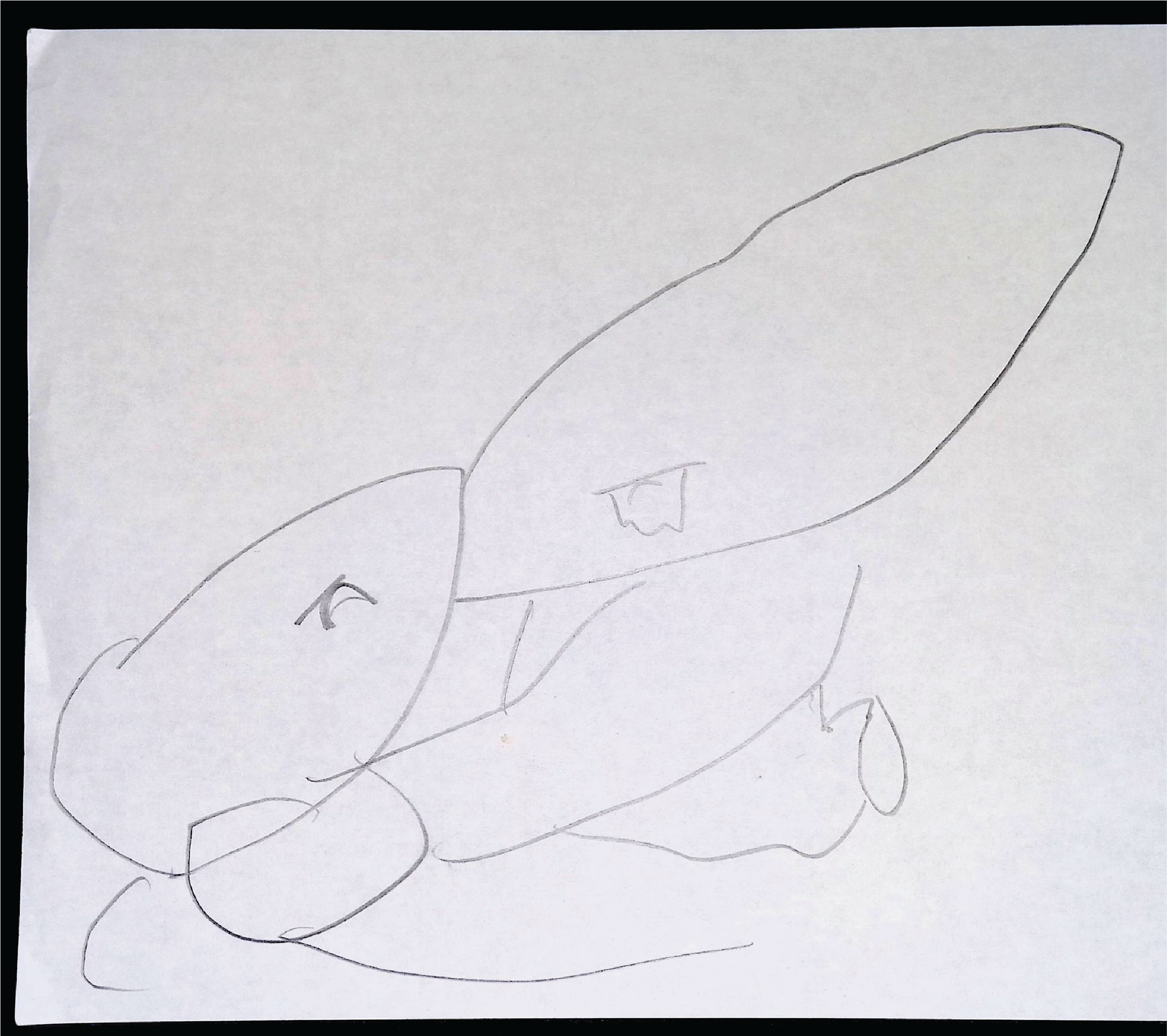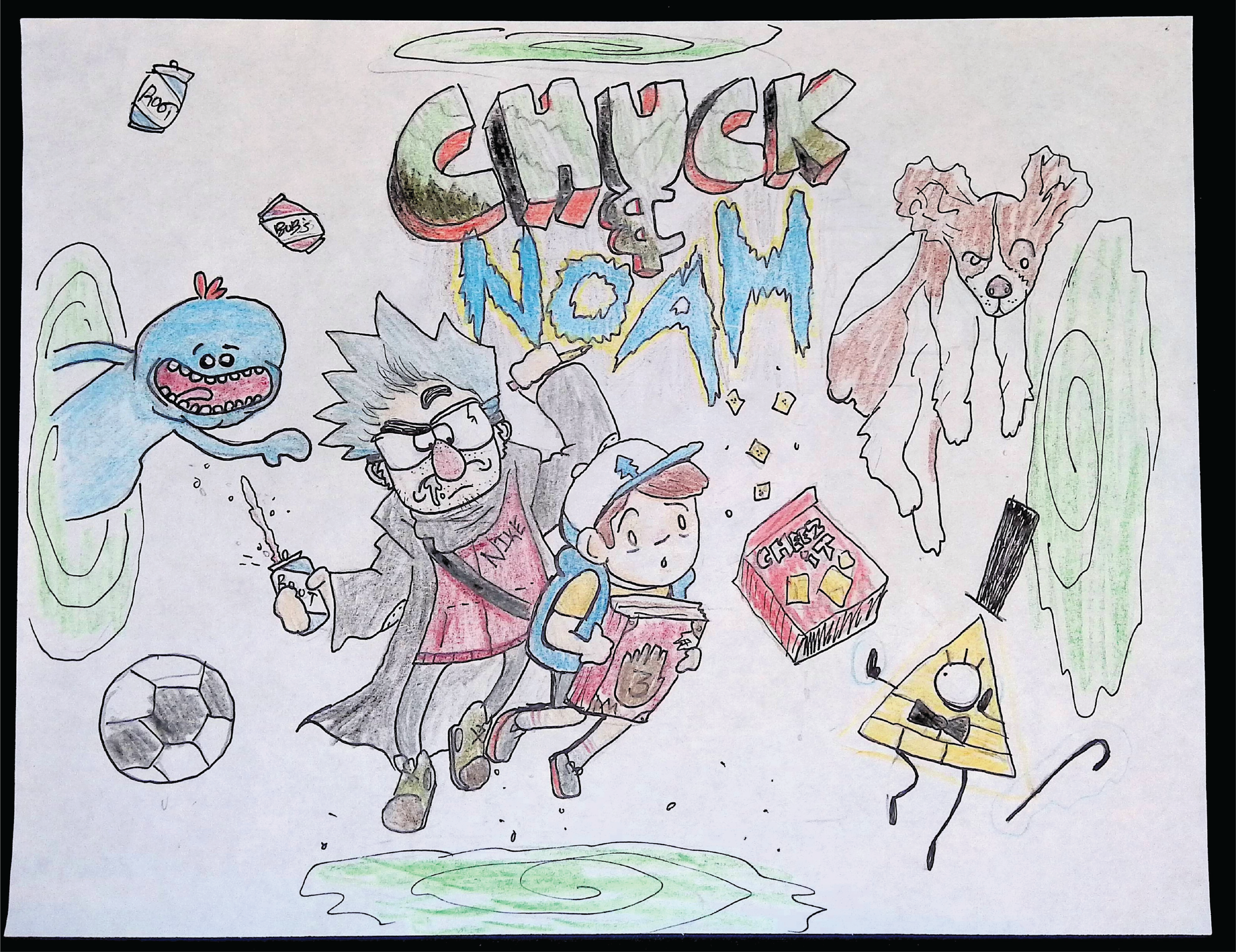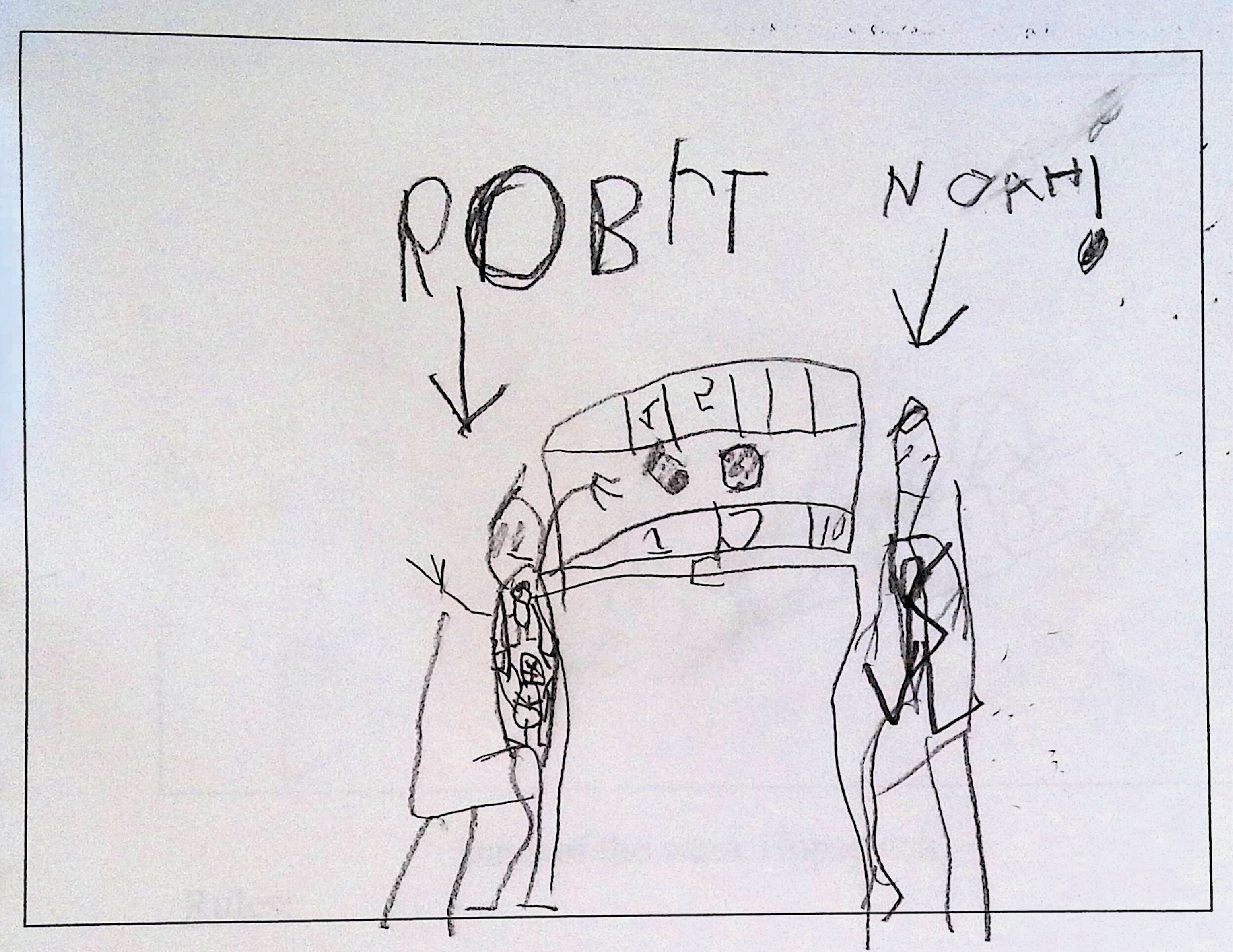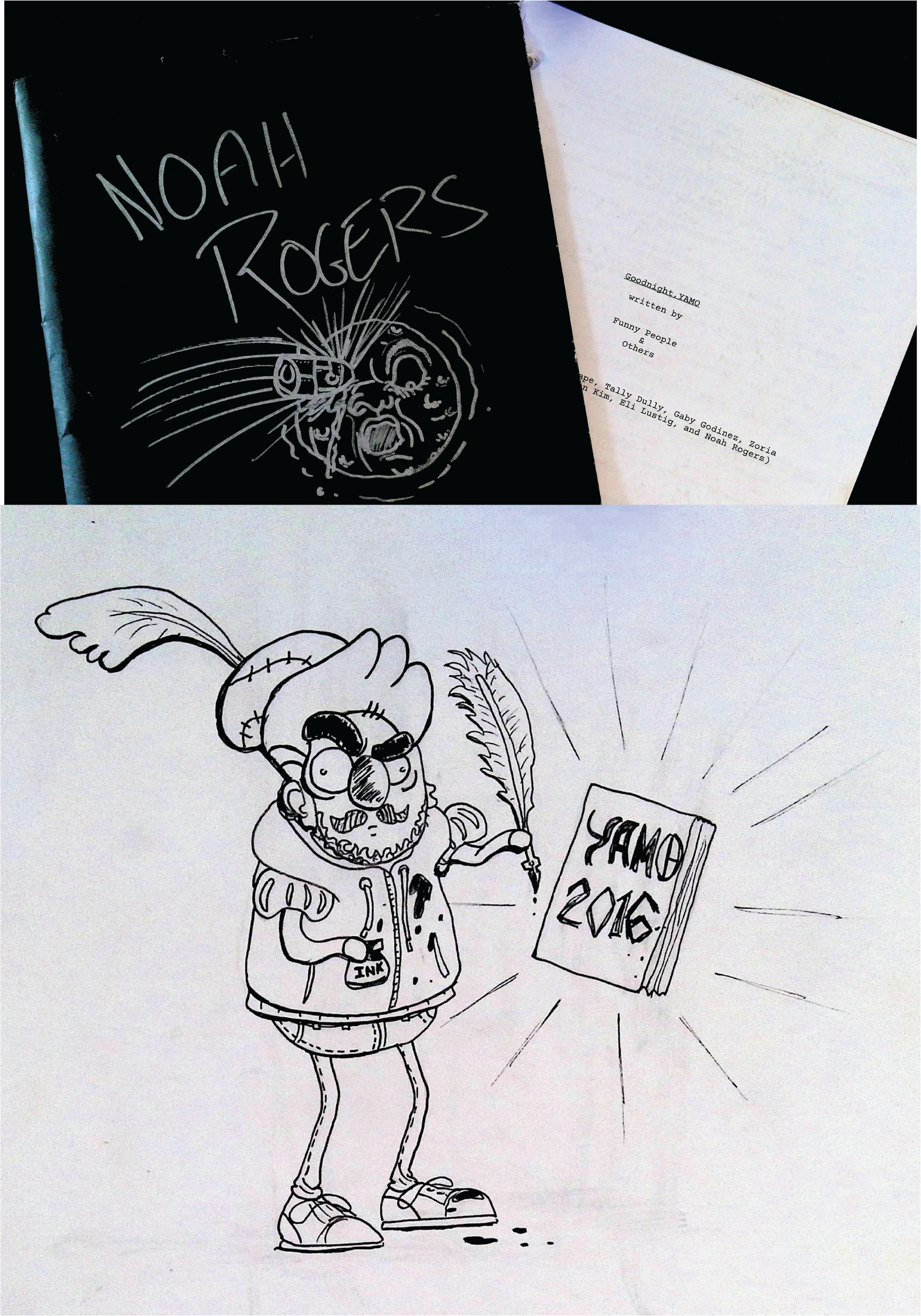

EMOTION EXPRESSION
Emotions drive the whole-body engagement in any story. As a baby, Noah responded to epic orchestral music – he would grow silent, his eyes would open wide and he’d stare as if seeing something astounding. He not only had a knack for understanding how music best matched the emotional mood of a story, in his drawings, he had an almost impressionistic ‘sloppy lined’ but effective urgency to communicate emotion through composition, shadow, facial expression and body language

E11. Self-Representation of Noah’s inner world. College Sketchbook

E10. Joe the clown stop-motion puppet. College Stop Motion Senior film character

E9. Caesar from Planet of the Apes remake. High School scratch board.

E8. Potentially character study of George Stenson, Jasper Falls Comic Strip. High School sketch book.

E7. ChuckBlubbs.com t-shirt design. Colander of the Dingle Bops. Summer before Freshman Year college.

E6. Marketing campaign for Goof Cards. High School design class.

E5. Self-portrait. High School summer before freshman year

E4. Study in the basic building blocks of human facial communication. High school cartooning class.

E3. Study in the basic building blocks of human facial communication. High School cartooning class.

E2. Early study of drawing basic emotions. Elementary school cartooning class.

E1. Contemplative drawing of Star Wars scene from sequence of 20 drawings. Kindergarten.
BUDDIES AND MISFIT BANDS
Important to all hero stories and to Noah’s philosophy of story are “best buddies” and “bands of talented misfits.” Noah’s stop-action film “Joe” was in essence a buddy film describing the relationship between a washed-up clown and a young street urchin.

BB15. Goodbye scene of two buddy characters from world extension comic of David Petersen’s MouseGuard. Middle school

BB12. Duplicated his favorite stop motion buddy teams in clay: Wallace and Gromit, Huxley Pig and Sam, Mort, and Mr. Bumpy and Squishy … as well as characters from the Mouseguard comic book . Elementary school, 4th – 6th grade.

BB13. Buddy drawing of Noah and Charlie reimagined as favorite cartoon characters: Rick and Morty, Gruncle Stan and Dipper. High school

BB14. Band of brothers - pop-culture mash-up comic. Highschool, 2014

BB11. Potential scene from ten year project named Bub – started in Elementary school. One of the last projects he worked on.

BB8. Scene from buddy movie created with creative band of brothers. Godsend, 2021

BB9. Joe and Scamp --- a stop motion buddy movie. College senior film, 2021

BB7. Dungeon and Dragon’s campaign band of brothers – ( later turned it into a 2d animation). College

BB6. Band of brothers sketch incorporating reimagining his friends in the Avatar world. Freshman year high school

BB5. Noah and Joe Star Wars series buddy comic --- Elementary school. There are at least 60 episodes.

BB4. Noah played the best friend in a movie with a buddy from middle school. The Fancy Pants movie, 2011

BB3. Noah joined football for the promise of “camaraderie” and “sports battle”. 5th grade.

BB2. School assignment illustration of “buddies” playing games. Kindergarten

BB1. Early example of buddy principle. Star Wars scene. Pre-school

BB10. Band of brothers - pop-culture mash-up comic. Highschool, 2015
QUEST - DESTINY
The theme of the "hero" and "friends' quest-destiny" propels characters forward to a destination they cannot deny. This was an underlying principle in all of Noah's buddy/band comic books. It also figured in his Lego, stop-motion, fan films and original films. It formed the basis for his Dungeons & Dragons (DnD) campaigns, too. Quest stories included expansive lists of characters and attention to detail--including costumes and personal effects as these represented characters' stations and powers. Artifacts were also important characters representing story themes carried through time cycles in destiny. Because hero's trials are episodic, Noah created episode after episode in these stories, shaping quest after quest for his favorite teams of characters. He loved DnD campaigns because they were an endless exercise in collaborative, improvisational story questing.

QD1. Notes for Mega-Dungeons and Dragons campaign including quest log, character drawings and overviews. College years

QD2. Map of Cross country quest with friend Henry Smith. Summer 2021

QD3. Costume detail of hero character from long term project “Benji / Bub”. College

QD4. The same fully realized costume from QD3. College

QD5. Bix Brody interplanetary ranger character. Bix Brody, college years.

QD6. Costume detail of pirate captain. Halloween, High School freshman

QD7. Detail, band of brothers comic. High School freshman

QD8. Detail of cast of characters in the “Benji / Bub” quest saga. High School freshman / sophomore.

QD9. Detail of cast of characters for the original “Carriers” comic series (also made into video). Middle School

QD10 Cover detail of an episode of The Carriers. 6th or 7th grade.

QD11. Cover of extension comic series of the Overlander YA book series Noah’s pen name during this time was WONRAH -- Noah WR (William Rogers) rearranged. 5th or 6th grade.

QD12. Detail of panel from Halo Reach world extension comic series. 3rd or 4th grade.

QD13. Four of the dozen extension comic series of the Mouseguard world. 4th through 8th grade.
BATTLE
By the time he was three Noah drew page after page of color explosions as he processed the scenes of battle he saw in his mind’s eye. As he grew, Noah even saw sports as a “band of brothers” battle to the point that he elevated a made-up family game to a club level sport at his college, attending to every detail, from art directing the uniform design, to shaping the field equipment and the ethos of the game.

B1. Contemplation of Star Wars battle drawing. Pre-school

B2. Potentially Doc Oc with Spiderman. Kindergarten.

B3. Mouseguard “extended world” series. Featuring his own character. Late elementary school

B4. Bat- Ball . With equipment design from high school design class. Sophomore year College

B5. Fighting mouse detail with costume notes. middle school.

B7. Mega battle. High school sketchbook

B6. Panel from “Noran Dejelk” a character he invented in his extended Star Wars Universe. Elementary school

B8. Mega battle with Noah as Scottish Highlander chieftain. Early college sketchbook.
HERO’S CODE
Connected to the hero’s philosophy of Quest-Destiny is the hero’s code of behavior and mindset: Loyalty, Fraternity, Kindness, Compassion, Mercy, Redemption, Valor, and Self-sacrifice were key values. The code is what separates the good guys from the bad guys, and Noah’s drawing of good and evil characters reflected this. In the spirit of “using his art to make sense of his world,” Noah included himself, often as the hero, in every comic adventure. He also loved theater for the same reason: He could use his imagination to become someone else and enter their story.

H1. All the boys wore their hero affinities to school whenever they could. Pre-school

H2. Honor among equals - -even characters who oppose each other at times. Middle school

H3. The hero takes the arrow to protect the innocent. Elementary school

H4. The hero sometimes makes the ultimate sacrifice in defense of the innocent and the weak. Elementary school

H5. Hero affinity in his signature Nike zip up sweatshirt. ComiCon (C2E2). Middle School.

H5. The hero’s sacrifice from the “Bub / Benji” series. Scratchboard, High School.

H6. Bub the hero demonstrating his power (notice the resemblance to Noah). High School sketchbook

H8. Noah’s list of all the roles he’d played in theater productions to that point. Journal, High school

H7. Mouseguard extension comic with Noah’s invented character – the Black Axe. Middle School

H9. Evil character from the “Bub” series. High School Sketchbook

H19. Animated Bix Brody interplanetary ranger series (aka Noah). College
COMEDY / TRAGEDY DUALITY
Finally, the two-piston engine of Noah's flavor of hero story is the comedy/tragedy duality: Heartfelt stories that make you laugh from the gut and cry from an even deeper place. In Noah's work, these took the form of cartoon commentary and slapstick films. To Noah, there was nothing more satisfying than making his friends laugh. Many of his artistic adventures centered on that effort, including elaborate pranks, irreverent takes on school assignments, DnD campaigns, doodles over every inch of his homework margins, buddy zines, and all manner of grandiose episodic pop culture mashups. Above all, Noah's favorite hero role was that of the clown.

CT1. Cartoon snapshot of a Risk game played with a band of buddies. High School

CT2. Early Noah humor on religion class assignment – Jesus’ mother Mary tells Jesus that the wedding planners have run out of “Nachos” and Jesus says “What?!”. Elementary school

CT3. School assignment for a short story. Monster broccoli that was not eaten when it could have been. Elementary school

CT4. Noah and all his siblings were a part of the noted tradition of the Evanston Township Highschool student run sketch-comic show, YAMO. The experience definitely impacted Noah’s sense of humor and scene writing. Sophomore year, High School

CT5. Noah was the lead sketch writer for YAMO in his Senior year. High School, 2016

CT6. Noah invented a greeting card line for awkward people called “Goof Cards”. High school design class.

CT7. Noah combining humor (comedy) with the tragic view of a cartoon who is almost to the end of his panel. Highschool

CT9. Noah was a staff cartoonist for the school student paper. Highschool

CT8. Cartoon version of Noah, one of many. Design notebook, High School

CT10. Tragic / comedic marketing campaign for a sentient Cheeze Head snack, High school design class.

CT11. Noah’s greeting card take on himself as Charlie Brown – a character he once played in a middle school production of “Charlie Brown Christmas” – perhaps a simpler time in his mind. College